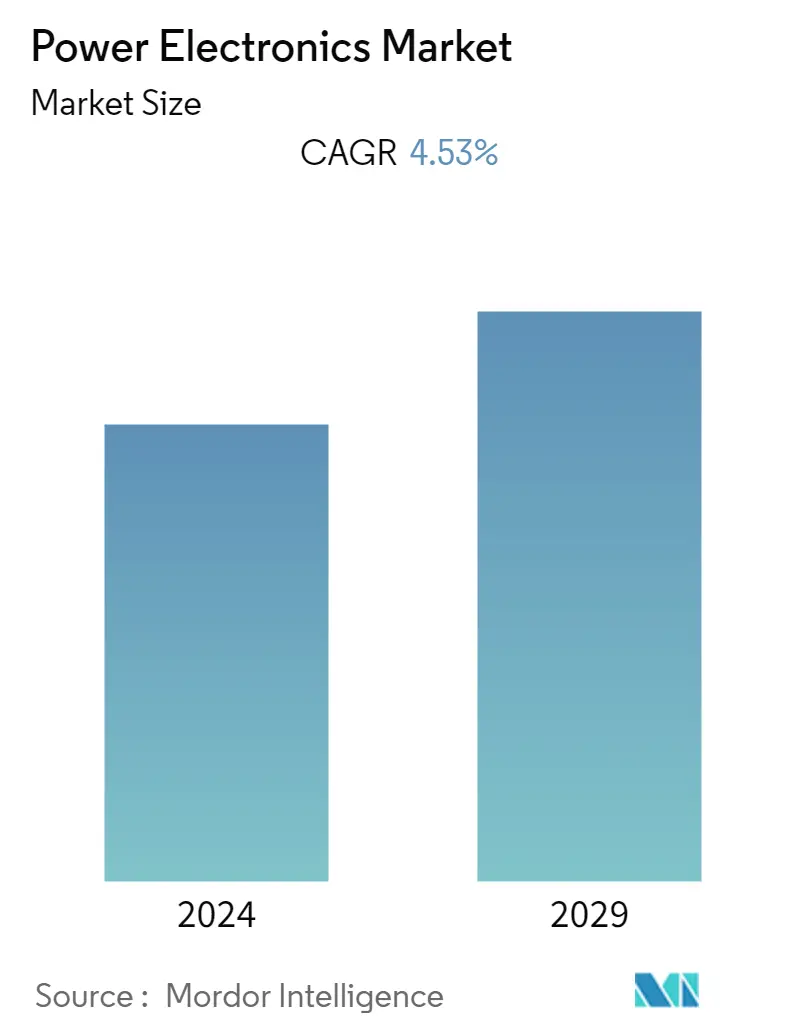Market Size of Power Electronics Industry

| Study Period | 2019 - 2029 |
| Base Year For Estimation | 2023 |
| CAGR | 4.53 % |
| Fastest Growing Market | Asia Pacific |
| Largest Market | Asia Pacific |
| Market Concentration | Low |
Major Players
*Disclaimer: Major Players sorted in no particular order |
Power Electronics Market Analysis
The power electronics market is estimated at USD 29.19 billion in the previous year. The market is expected to reach USD 37.72 billion over the forecast period, registering a CAGR of 4.53%. This growing demand for power electronics comes from various booming applications, including electric and hybrid electric vehicles (xEV), factory automation, photovoltaics, wind turbines, UPS, and home appliances.
- Notably, electrical energy consumption continues to grow, and more applications are being introduced based on electricity. More than 60 percent of total energy consumption is expected to be converted into electricity for use, and electrical energy must be produced, distributed, and used as efficiently as possible. Further, emerging climate change also argues for finding future sustainable solutions. Under such evolving circumstances, two major technologies that are likely to play essential roles in solving parts of those future problems include the change in electrical power production from conventional, fossil (and short-term) based energy sources to renewable energy sources and usage of highly efficient power electronics in power transmission/distribution, power generation, and end-user application, thus driving the role of power electronics.
- The power electronics industry is experiencing a dynamic environment that is constantly changing due to numerous trends. As power electronic devices and systems exist throughout the power supply chain, from the power plant to the entire power grid, the factors that influence them can vary widely. And then to items that consume electricity. All are very different environments and are affected differently.
- Reducing energy consumption is one of the major trends impacting the energy industry, and power electronics are emerging as a key technology to precisely control the flow of electrical energy from the source to the load, depending on the load requirements. Thus, it is responsible for the reliability and stability of the whole power supply infrastructure from the sources, the energy transmission and distribution up to the huge variety of applications in the industry, transportation systems, and home and office appliances.
- For instance, advanced power electronics could realize savings of about 50 percent of the energy losses in converting from mains or battery voltages to those being utilized in electronic equipment. But despite the tremendous importance of power electronics, there needs to be more awareness of the role of power electronics in modern industrial society, even in the well-informed general public.
- The pandemic also accelerated the adoption of IoT, which positively impacted the market. For instance, a recent study by global mobile satellite provider Inmarsat found that the maturity of companies adopting the Industrial Internet of Things (IoT) has increased rapidly since the start of the COVID-19 pandemic.
Power Electronics Industry Segmentation
Power electronics include components such as capacitors, inductors, and other semiconductor devices used in the power management of various systems. Moreover, power electronics integrate energy, control systems, and electronic devices.
The study includes two types of components and materials for various end-user industries. The competitive landscape has been considered to calculate the power electronics penetration and the involvement of the key players in organic and inorganic growth strategies. These companies continuously innovate their products to increase their market share and profitability. Further, the market study also focused on the impact of the COVID-19 pandemic on the market ecosystem.
The power electronics market is segmented by component (discrete and modules), by material (silicon/germanium, silicon carbide (sic), and gallium nitride (gan)), by end-user industry (automotive, consumer electronics, IT and telecommunication, military & aerospace, industrial, energy and power, and other end-user industries), and geography (North America, Europe, Asia Pacific, Latin America, and Middle East and Africa). The market size and forecasts are provided in terms of value (USD) for all the above segments.
| By Component | |
| Discrete | |
| Module |
| By Material | |
| Silicon/Germanium | |
| Silicon Carbide (SiC) | |
| Gallium Nitride (GaN) |
| By End-user Industry | |
| Automotive | |
| Consumer Electronics | |
| IT and Telecommunication | |
| Military and Aerospace | |
| Industrial | |
| Energy and Power | |
| Other End-user Industries |
| By Geography | |
| North America | |
| Europe | |
| Asia-Pacific | |
| Latin America | |
| Middle East and Africa |
Power Electronics Market Size Summary
The power electronics market is poised for significant growth, driven by the increasing demand for energy-efficient solutions across various sectors. This demand is largely fueled by the rising adoption of electric and hybrid vehicles, advancements in factory automation, and the expansion of renewable energy sources like photovoltaics and wind turbines. As the world shifts towards more sustainable energy consumption, power electronics play a crucial role in enhancing the efficiency of power generation, transmission, and distribution. The industry's dynamic nature is influenced by trends such as the need for reduced energy consumption and the integration of IoT technologies, which have gained momentum post-pandemic. These factors underscore the importance of power electronics in ensuring the reliability and stability of power supply infrastructures, from generation to end-user applications.
Regionally, the Asia-Pacific area dominates the power electronics market, supported by its strong semiconductor industry and favorable government policies. Countries like China, Japan, and South Korea are at the forefront, with significant contributions from emerging markets such as Vietnam and Thailand. The region's growth is propelled by the burgeoning electric vehicle industry, increasing demand for renewable energy, and advancements in industrial automation and consumer electronics. The competitive landscape is marked by the presence of major global players like ON Semiconductor, Infineon, and STMicroelectronics, who continue to innovate and expand their product offerings to meet the growing market demands. As the industry evolves, the focus on high-efficiency power supplies and semiconductors is expected to drive further advancements and opportunities in the power electronics sector.
Power Electronics Market Size - Table of Contents
-
1. MARKET INSIGHTS
-
1.1 Market Overview
-
1.2 Industry Attractiveness - Porter's Five Forces Analysis
-
1.2.1 Bargaining Power of Suppliers
-
1.2.2 Bargaining Power of Buyers
-
1.2.3 Threat of New Entrants
-
1.2.4 Threat of Substitutes
-
1.2.5 Intensity of Competitive Rivalry
-
-
1.3 Assessment of COVID -19 impact on the Industry
-
1.4 Technology Snapshot
-
1.4.1 Power Generation and Storage
-
1.4.2 Sensing and Measurement
-
1.4.3 Power Management and Distribution
-
1.4.4 Other Functions
-
-
-
2. MARKET SEGMENTATION
-
2.1 By Component
-
2.1.1 Discrete
-
2.1.2 Module
-
-
2.2 By Material
-
2.2.1 Silicon/Germanium
-
2.2.2 Silicon Carbide (SiC)
-
2.2.3 Gallium Nitride (GaN)
-
-
2.3 By End-user Industry
-
2.3.1 Automotive
-
2.3.2 Consumer Electronics
-
2.3.3 IT and Telecommunication
-
2.3.4 Military and Aerospace
-
2.3.5 Industrial
-
2.3.6 Energy and Power
-
2.3.7 Other End-user Industries
-
-
2.4 By Geography
-
2.4.1 North America
-
2.4.2 Europe
-
2.4.3 Asia-Pacific
-
2.4.4 Latin America
-
2.4.5 Middle East and Africa
-
-
Power Electronics Market Size FAQs
What is the current Power Electronics Market size?
The Power Electronics Market is projected to register a CAGR of 4.53% during the forecast period (2024-2029)
Who are the key players in Power Electronics Market?
ON Semiconductor Corporation, ABB Ltd., Infineon Technologies AG, Texas instruments Inc. and ROHM Co. Ltd are the major companies operating in the Power Electronics Market.

